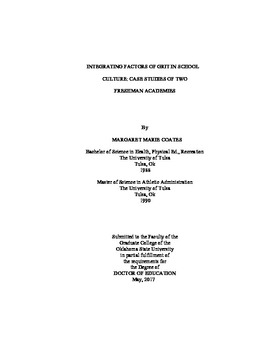| dc.description.abstract | The purpose of this qualitative case study is to explore the cultural manifestation of grit in two freshman academy environments and describe factors of grit that support student success. This study used purposeful sampling to select sites and participants. Data were collected through: administration of Douglas' (1982) grid and group 24-question survey to determine cultural typology of each school; the administration of Duckworth's (2007) 8 item, Grit-S scale to determine the "grittiness" of each faculty; structured interviews with four teachers and one assistant principal from each site; observations, documents, photographs, electronic communication, flyers, demographic reports, and school websites. Douglas' (1982) grid and group matrix was used as the theoretical framework to explore the cultures of each school and to understand how Duckworth and Quinn's "two-factor" construct of grit, which is consistency of interest and perseverance of effort, is culturally manifested in each school. This study provides analysis of these cases with regard to the four psychological assets of grit, as it relates to the organizational environment of each school: interest (teacher/student school passion); practice (routine school activities); purpose (school vision, mission, and goals); and hope (optimism, opportunities) (Duckworth, 2016). Findings revealed that by examining grid dimensions of each school, the similarities and differences of grit were manifested with regard to teacher and administrator roles, organization and structure of the school, and school programs could be explained. Additionally, by examining group dimensions of each school, similarities and differences of how grit was manifested in teacher goals, stakeholder expectations, collaboration, and stakeholder relationships could be explained. Programs that contributed to the development of grit were those that allowed opportunities for students to engage with technology, their peers, and their teachers, as well as programs that provided time for academic supports. Findings confirmed grit development is possible within a freshman transition program and is manifested in programs and supports for teachers and students in a culture of high expectations, collaboration, supports for students and teachers, and an environment of relationship building. Implications for practice include, the promotion of grit in learning environments, teacher education programs, and improved four-year cohort graduation rates. | |
